Ralph Savelsberg 「これはあなたが探し求めているICBMではない:北朝鮮のミサイルの詳しい分析 (This Is Not The ICBM You Are Looking For; Detailed Analysis Of North Korean Missile)」 (2017年7月6日 「BREAKING DEFENSE」)
6日、Breaking Defenseにオランダ国防大学のRalph Savelsberg先生が書かれた「これはあなたが探し求めているICBMではない:北朝鮮のミサイルの詳しい分析 (This Is Not The ICBM You Are Looking For; Detailed Analysis Of North Korean Missile)」 が掲載された。訳出掲載許可は頂いているので、訳出掲載する。
Breaking Defense, Ralph Savelsberg, This Is Not The ICBM You Are Looking For; Detailed Analysis Of North Korean Missile, http://breakingdefense.com/2017/07/this-is-not-the-icbm-you-are-looking-for-detailed-analysis-of-north-korean-missile/
Permission to translate and publish this article on my blog is explicitly given by the author, Ralph Savelsberg.
**********************
これはあながた探し求めているICBMではない:北朝鮮のミサイルの詳しい分析
This Is Not The ICBM You Are Looking For; Detailed Analysis Of North Korean Missile, http://breakingdefense.com/2017/07/this-is-not-the-icbm-you-are-looking-for-detailed-analysis-of-north-korean-missile/
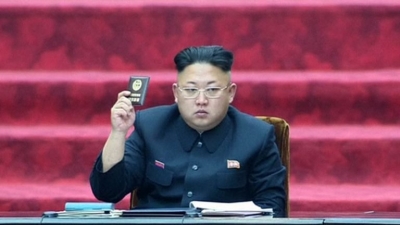
北朝鮮は巧みな演出家:ミサイルを搭載した16輪の大型オフロードトラックが平壌の通りを通り抜けることで、「アメリカ野郎」に北朝鮮は信頼できる複数のICBMを保有していることを示している。
North Koreans are showmen: large 16-wheeled off-road trucks carrying missiles through the streets of Pyongyang are all about showing the ‘American Bastards’ that North Korea has credible road-mobile ICBMs.
Source: Breaking Defense, http://breakingdefense.com/2017/07/this-is-not-the-icbm-you-are-looking-for-detailed-analysis-of-north-korean-missile/
自分の式が好きな「若い将軍」金正恩は、ICBMがサンディエゴ、テキサス、ワシントンDCを威嚇できるとすら表明した。アメリカの指導者達は、ミサイルのモックアップと射程距離の主張を現実の脅威とすることで、効果的に北朝鮮の主張を裏書きした。米国ミサイル防衛局(MDA)は、脅威の現実性とタイミングにかかわらず、44基の地上配備型迎撃ミサイル(GBI)委託配備を正当化するために、脅威となるミサイルの数について直ちに声を上げた。北朝鮮は、米国に彼らを「適切な尊厳」を持って扱わさせるよう影響を与えるために、編集された写真や動画の共有に驚くほどオープンである。銀河衛星運搬ロケット、火星-10(米国では一般的にムスダンと呼ばれている)、火星-12、そして今回、米国の記念日を北朝鮮式に祝賀するため、独立記念日を特に選んで打ち上げられた火星-14など4種のミサイルが、ICBM計画に関する見解に影響を与えるために、公開あるいは発射された。
The ‘Young General,’ as Jim Jong-Un likes to style himself, has even claimed those ICBMs can threaten San Diego, Texas and Washington DC. American leaders have effectively endorsed North Korean claims, by treating the missile mock-ups and range claims as if the threat is real. The US Missile Defense Agency (MDA) has talked up the immediacy and numbers of the threat missiles to justify their mandate for 44 GBIs, regardless of any doubts expressed as to the reality and timing of the threat. The DPRK has been remarkably open with sharing edited photos and video of successes in order to influence the US to treat them with ‘appropriate respect’. Four missiles have been shown or flown to influence opinions about the ICBM program: the Unha SLV, the Hwasong 10 (usually called Musudan in US sources), the Hwasong 12 and now the Hwasong 14, flown expressly on the fourth of July to provide a North Korean flavor to celebrating the American holiday.
この記事では、ミサイル技術の原則に基づく工学的検証から導かれる明白な疑問、「数年前までは50年代のロシアのミサイルのコピーしか作れなかった小国が、なぜ液体燃料を用いた移動式ICBM(ソ連によっても米国によっても成し遂げられなかった偉業)を製造したと主張し、それが米本土に脅威を与えているのか」、「火星-14は何であり、それが我々に何を教えているのか」について扱うことにする。
This article applies missile engineering principles in a directed engineering forensic look to ask the obvious questions: how does a small country that, until a few years ago, was limited to building copies of Russian missiles from the fifties, claim to build a road-mobile liquid propellant ICBM (a feat never achieved by either the Soviets or the US) and have that missile threaten the continental US? This is clearly unlikely as an engineering achievement, so what is the Hwasong-14 and what does it teach us?
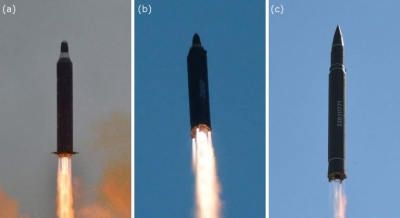
図1: 2016年6月に打ち上げられた火星-10(ムスダン)(a)、今年5月14日に打ち上げられた火星-12(b)と7月4日に打ち上げられた火星-14(c)。(イメージはKCNAにより、大きさを比較するためのものではない)
Source: Breaking Defense, http://breakingdefense.com/2017/07/this-is-not-the-icbm-you-are-looking-for-detailed-analysis-of-north-korean-missile/
2016年6月、北朝鮮は火星-10として知られる新型弾道ミサイルの発射の様子を公開した。このミサイルは、それまでは平壌での軍事パレードの中で見られただけであった。成功した打ち上げで、このミサイルはロフテッド軌道で400km飛行し、高度約1400kmに達した。写真と軌道から、エンジンの構造はソ連のSS-N-6 SerbあるいはR-27潜水艦発射型弾道ミサイルと類似しており、1基のメインエンジンと操縦用に別の2基のバーニアスラスタが搭載されていることが確認された。北朝鮮の銀河-3衛星運搬ロケットには、3段目の推進力を得るためにR-27の2基のバーニアスラスタが使われているようであり、このことからして、北朝鮮がR-27の技術とエンジン組立に接近している可能性が確認できる。R-27には、知られているスカッド改良型よりも多くの推進混合剤(enegetic propellant mixture)と酸化剤としてのN204が、燃料としのUDMH(Unsymmetrical Dimethyl Hydrazine)と共に用いられた。しかし、N204の安定性は比較的低い温度範囲において維持されるので、移動式ミサイルには適してない。したがって、ムスダンはUMDHを燃料として使っているにもかかわらず、IFRNA(inhibited Red fuming nitric acid)を酸化剤の代わりに用いているようである。ロフテッド軌道によるコンピュータ・シミュレーションでは、ミサイルはペイロード(積載重量)なしで打ち上げられたことを示しているが、650kgのペイロードがあったとしても、ミサイルは約2100km飛行可能である。明らかに、ムスダンの性能はソ連の原型ミサイルよりも全ての指標において劣る設計であり、原型のR-27よりも全てのペイロード条件において飛行距離が短く、信頼性に劣り、精度が低い。
In June 2016, North Korea released launch footage of a new ballistic missile, known as the Hwasong 10. This had previously only been seen during parades in Pyongyang. During its single successful flight, it flew a lofted trajectory over a distance of 400 km, reaching an altitude of roughly 1,400 km. Photographs and the trajectory confirmed that its engine configuration is similar to the Soviet SS-N-6 Serb/ R-27 submarine-launched ballistic missile, with a single main engine and two separate smaller vernier engines for steering. North Korea’s Unha 3 Space Launch Vehicle appears to use two R-27 vernier engines to power its third stage, appearing to confirm North Korean access to R-27 technology and engine assemblies. The R-27 used a more energetic propellant mixture than North Korea’s known Scud-derivatives, with N2O4 as the oxidizer and UDMH (Unsymmetrical Dimethyl Hydrazine) as the fuel. N2O4 has use constraints within a relatively small temperature range, however, that make it ill-suited for a mobile missile. Therefore it seems likely that the Musudan uses IFRNA as the oxidizer instead, albeit still with UDMH as fuel. Computer simulations of the lofted trajectory show that it was most likely flown without a payload and that, with a payload of 650 kg, the missile can travel a distance of approximately 2,100 km. Notably the modeling showed that the Musudan was less capable than the original Soviet missile in every military aspect: it has less range for all payloads, is less reliable and is probably far less accurate than the original R-27.
5月に、新型の火星-12と呼ばれるミサイルが発射された。このミサイルも以前、4月の金日成誕生日105周年記念軍事パレードで目撃された。このエンジンの構成は図1bのようになっており、ムスダンと比較した場合、ムスダンが2基のバーニアスラスタを搭載しているのに対して、こちらは4基搭載している点で異なる(大きさを詳細に比較してみれば、火星-12のバーニアスラスタの方が、それぞれの噴出力が大きいことが分かるであろう)。この構成は、2017年3月に行われた地上噴出実験と類似しており、エンジンも新型だと思われるが、コンピュータによるシミュレーションでは性能はR-27に近く、燃料としてN204とUDMHを使っているようであることが分かった。シミュレーションはまた、重量がムスダンや古いスカッド改良型よりもかなり軽いということを示しており、それは構造的な弱さにもつながっている。このミサイルをTELに搭載して運搬したり、燃料注入後に起き上がらせることは、大規模な爆発につながる可能性がある。650kmのペイロードを搭載し、このミサイルは3700km飛行し、グアムは十分に打撃できる。
In May of this year another new missile, called the Hwasong 12, was launched. This too had been seen before during a parade, staged in April to celebrate Kim Il Sung’s 105th birthday. Its engine configuration, shown in Figure 1b, is different from the Musudan in that it has four vernier engines rather than two (detailed size comparisons may show larger thrust capabilities per engine from the Hwasong 12 verniers). This is similar to the arrangement shown in a static ground test from March 2017 and the engine may be new, but computer simulations suggest that its performance is similar to that of the R-27 and that it likely uses N2O4 and UDMH as the propellant. The simulations also show that the structure of the missile is a lot lighter than that of the Musudan or older Scud-derivatives, making it rather fragile. Driving it around on top of a TEL or erecting it when fueled is a recipe for a large explosion. With a payload of 650 kg, it can reach a distance of approximately 3,700 km; enough to strike Guam.
今週初めに打ち上げられた火星-14もまた、高度のロフテッド軌道で飛行した。北朝鮮の情報によると、このミサイルは933km飛行し、高度2802kmに達し、総飛行時間は約39分であったという。こうした数値が正確だと仮定すると、性能の向上は著しいのであるが、これを長く待ちわびていた地上移動式のICBMと認定することができるのだろうか。コンピューター・シミュレーションによる工学分析が、この疑問に答えてくれる。シミュレーションに必要なミサイルの諸元は、既存のミサイルや発射の写真から得ることができる。
The Hwasong 14 launched earlier this week also flew on a highly-lofted trajectory. According to North Korean sources, it covered a distance of 933 km while reaching an apogee of 2,802 km, with a total flight time of approximately 39 minutes. Assuming that these numbers are accurate, the performance increase is significant, but does this qualify as the long-awaited road-mobile ICBM? Engineering forensic analysis by computer simulations addresses this question. The missile parameters required for the simulations can be derived from existing missile models and photographs of the launch.
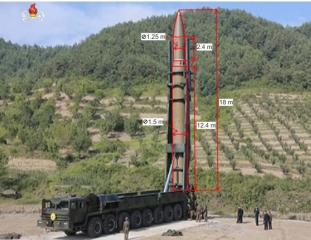
図2: 輸送車両に搭載された火星-14のおおよそのサイズが記されている。(オリジナル写真はKCTV<訳注:「KCNAテレビ」とあるが、これは明らかなエラーなので、筆者に知らせてある>)
Source: Breaking Defense, http://breakingdefense.com/2017/07/this-is-not-the-icbm-you-are-looking-for-detailed-analysis-of-north-korean-missile/
図1cに示された1段目のエンジンは、火星-12と同じ構成になっている。図2は、先の軍事パレードでも使われた中国製のWS51200と思われる輸送車に積まれたミサイルである。国連の調査によると、6台のこうした輸送車が北朝鮮に「木材運搬車」として売られ、北朝鮮が購入後、「使用契約」に違反して禁止されている輸送起立発射機(Transporter-Erector-Launchers)に改造したという。車両に火星-14が寝かされた状態で搭載されている他の写真からは、ミサイルが車両よりもわずかに短いことが分かる。こうしたことから、図2にあるようにミサイルのサイズを推測することができる。こうしたことからして、1段目は基本的に火星-12と同じであることが確認できる。2段目は、銀河-3の上段部分ととても似て見えるが、タンクは短くなっている。これらの諸元を表1に表した。
The first-stage engines, shown in Figure 1c, have the same configuration as that of the Hwasong 12. Figure 2 shows the missile and its transport vehicle, which appears to be a Chinese-built WS51200 as used during earlier parades. According to a UN investigation, six of these trucks were sold to North Korea as ‘lumber transporters’ and, after the sale, North Korea violated the ‘end user certifications’ by modifying them back to banned Transporter-Erector-Launchers. Other photographs, with the Hwasong 14 lying on top of the vehicle, show that it is marginally shorter than the vehicle. This allows estimating the dimensions of the missile, as shown in Figure 2. These confirm that the first stage is essentially identical to the Hwasong 12. The second stage looks very similar to the upper stage of the Unha 3, albeit with shortened tanks. The matching parameter set is listed in table 1.
表1: 火星-14の諸元
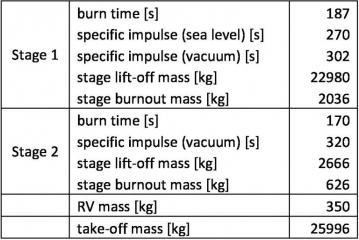
1段目: 燃焼時間187秒、比推力(海抜)270秒、比推力(真空)302秒、発射時重量22980kg、バーン・アウト時重量2036kg
2段目: 燃焼時間170秒、比推力(真空)320秒、発射時重量2666kg、バーン・アウト時重量626kg
弾頭部重量350kg
発射時重量25996kg
Source: Breaking Defense, http://breakingdefense.com/2017/07/this-is-not-the-icbm-you-are-looking-for-detailed-analysis-of-north-korean-missile/
こうした諸元を基に、バンヒョンから70度の方向に向けて発射され、ロフテッド軌道で933km飛行した場合のシミュレーションを行った。その結果は図3の通りである。
With these parameters, a lofted trajectory over a distance of 933 km was simulated, with a launch from Panghyon and an initial heading of 70°. The result is shown in Figure 3.
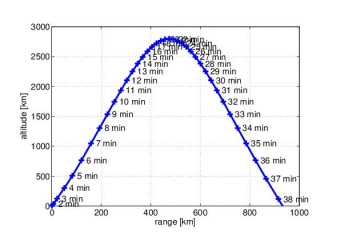
図3: 7月4日、火星-14がロフテッド軌道で飛行したシミュレーション
Source: Breaking Defense, http://breakingdefense.com/2017/07/this-is-not-the-icbm-you-are-looking-for-detailed-analysis-of-north-korean-missile/
最大到達高度はほぼ2800kmで、飛行時間は39分と、報じられている数値と類似している。シミュレーションで使った弾頭部重量は350kgで、これはこのサイズの一般的な空の耐熱シールドよりも重いが、実用的なペイロードよりは遙かに軽い。表1にあるバーン・アウト時の重量は、重量の約23%である。これはかなり重く、誘導装置のケース(housing)と短くされた2段目が、空の状態の重量軽減につながっていないことを示している。残念ながら、ロフテッド軌道のシミュレーションでは、2段目と弾頭部の空重量の違いをそれぞれの重さが独特なので、区別できていない。軽量化された燃料タンクは、ほぼ同じ軌道でより重いペイロード搭載を可能にする可能性がある。これを証明するために、比較的重いタンクがある2段目と150kgに軽量化された2段目をペイロード対距離比で、2つのシミュレーションを行った。後者の場合、2段目のバーン・アウト重量は総重量の19%となる。結果は図4の通りである。
The maximum altitude reached indeed is close to 2,800 km and the total flight time is close to 39 minutes, similar to the reported values. The RV mass in the simulation is 350 kg, which is heavier than one would expect for an empty heat shield of this size, but is much lighter than a useful payload. The burnout mass of the second stage, in Table 1, is approximately 23 percent of the total mass. This is fairly heavy, as housing the guidance equipment and shortening the length of the stage provide only small decreases in the empty mass. Unfortunately, simulations of lofted trajectories do not differentiate between the empty mass of the second stage and the RV mass, as only their sum is unique. A lighter second stage tank would allow a heavier payload for roughly the same trajectory. To account for this, two series of simulations were done, of payload versus range: one with the relatively heavy second stage tankage and one with a light second stage, with the mass reduced by 150 kg. In the latter case the stage burnout mass is 19 percent of the total stage mass. Results are shown in figure 4.

図4: 比較的重い2段目(青)と軽い2段目(赤)でのパイロード対飛行距離
Source: Breaking Defense, http://breakingdefense.com/2017/07/this-is-not-the-icbm-you-are-looking-for-detailed-analysis-of-north-korean-missile/
650kgというかなり軽いペイロードでは、重い2段目の飛行距離は最大ほぼ5240kmに達している。これは、1段構造の火星-12と比較した場合、実に重大な性能向上である。初期の核爆弾の重さである1000kgのペイロードでは、3800km飛行距離となる。
図4のシミュレーションは、地球の自転を無視している。現実には、西に向けて発射した場合の飛行距離は長くなり、東に向けて発射した場合の飛行距離は短くなる。この現象を勘案してヴィジュアルに表したのが図5で、重い2段目にも軽い2段目にも650kgの弾頭が搭載されていることにしている。両方ともアラスカの一部、ハワイが到達圏内に含まれている。そして、両方とも中国全土とロシア連邦のほとんどの地域が到達圏内に含まれている
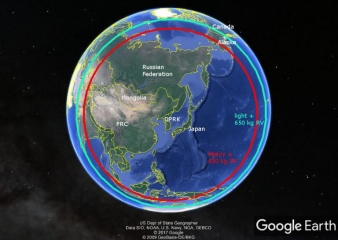
図5: 650kgの弾頭を搭載した、2種類の2段目の火星-14がカバーする地域。Google Earthを使ったビジュアル化。
Source: Breaking Defense, http://breakingdefense.com/2017/07/this-is-not-the-icbm-you-are-looking-for-detailed-analysis-of-north-korean-missile/
これらの結果には一定の不確実性がもちろんある。ロケット科学は魔法ではない。それは、化学と物理学の制約を受ける工学である。よりよい映像を使ったより詳細な分析によって、より正確な結果を出すことができる。北朝鮮は、ミサイルが「大型の重量」核弾頭を運搬でき、2段目には新型の高出力エンジンを使っていると主張している。推進燃料の量はミサイルの大きさの制約を受け、出力は特定の比推進力の制約を受ける。もし2段目に高出力エンジン装着されていたならば、それはより短い燃焼時間を意味するだけで、バーンアウト時の速度と距離においては、実質的に小さな違いしか生み出さない。シミュレーションでは、2つの小さなバーニアスラスタで性能が十分に向上されていたことを示している。1段目のエンジンの出力はミサイル全体を打ち上げるのに十分であるが、打ち上げに必要な余裕は少ししかない。そのため、さらに重い2段目を運搬することはできないであろう。
There is a degree of uncertainty in these results, of course. Rocket science is not magic. It is engineering constrained by chemistry and physics. Applying a more detailed analysis on better images would result in more refined results. North Korea claims that the new missile can carry a “large-size heavy” nuclear warhead and that the second stage uses a new high-thrust engine. The total propellant mass in a missile stage is limited by its size and the thrust is limited by the specific impulse of the propellant. If the second stage had a high-thrust engine, this would merely result in a shorter burn time, with only a small net result in burnout velocity and range. The simulations show that two smallish vernier engines are already enough to explain the performance increase. The thrust of the first stage engines is enough to lift the mass of the missile, but with only a small margin. It would not be able to carry a much heavier second stage.
ICBMの到達距離は、少なくとも5500kmである。750kg以下の弾頭か、より軽いミサイルであればこれを超えられる。火星-12のように、N204を使用し、軽量構造の先天的脆弱性は、移動しての使用を制約するし、輸送車両の数も限られている。このミサイルに関しては、誤解(deception)を生み出す要素も強いので、我々は科学と工学を注意深く用いて、見せられたものを理解するための疑いを持って、分析しなければならない。得られるデータに基づけば、これは液体燃料を用いた移動式ICBMではない。
An ICBM has a range of at least 5,500 km. Only the lighter version can exceed this and only with an RV mass of 750 kg or less. Like the Hwasong 12, the use of N2O4 and the innate frailty of the light-weight structure limits mobile use, as does the limited number of capable transporters. The force of deception is strong with this one, so we must use the science and engineering carefully and with skepticism to understand what has been shown. Based on the available data, this is not a liquid propellant road-mobile ICBM.
Ralph Savelsbergはデン・ヘルダー(Den Helder)にあるオランダ国防大学(the Netherlands Defense Academy)の准教授で、専攻はミサイル防衛。著者は、川口智彦の示唆とコメントに感謝する。
Ralph Savelsberg is an associate professor at the Netherlands Defense Academy in Den Helder, specializing in missile defense. The author would like to thank Tomohiko Kawaguchi for his suggestions and comments.
*****************
上記翻訳は、ミサイルに関する技術的知識がほとんどない素人の私が行ったものであり、技術用語などにおいて不適切な翻訳がなされている可能性があることをあらかじめお断りしておく。もし何かに引用する場合は、添付してある原文を十分に吟味された上で引用されたい。
静止画や動画をいち早く提供したり、朝鮮語の関連部分を英訳して伝えただけ、あとは素人の質問をしただけなのに、名前まで出して頂き、恐縮している。
Breaking Defense, Ralph Savelsberg, This Is Not The ICBM You Are Looking For; Detailed Analysis Of North Korean Missile, http://breakingdefense.com/2017/07/this-is-not-the-icbm-you-are-looking-for-detailed-analysis-of-north-korean-missile/
Permission to translate and publish this article on my blog is explicitly given by the author, Ralph Savelsberg.
**********************
これはあながた探し求めているICBMではない:北朝鮮のミサイルの詳しい分析
This Is Not The ICBM You Are Looking For; Detailed Analysis Of North Korean Missile, http://breakingdefense.com/2017/07/this-is-not-the-icbm-you-are-looking-for-detailed-analysis-of-north-korean-missile/

北朝鮮は巧みな演出家:ミサイルを搭載した16輪の大型オフロードトラックが平壌の通りを通り抜けることで、「アメリカ野郎」に北朝鮮は信頼できる複数のICBMを保有していることを示している。
North Koreans are showmen: large 16-wheeled off-road trucks carrying missiles through the streets of Pyongyang are all about showing the ‘American Bastards’ that North Korea has credible road-mobile ICBMs.
Source: Breaking Defense, http://breakingdefense.com/2017/07/this-is-not-the-icbm-you-are-looking-for-detailed-analysis-of-north-korean-missile/
自分の式が好きな「若い将軍」金正恩は、ICBMがサンディエゴ、テキサス、ワシントンDCを威嚇できるとすら表明した。アメリカの指導者達は、ミサイルのモックアップと射程距離の主張を現実の脅威とすることで、効果的に北朝鮮の主張を裏書きした。米国ミサイル防衛局(MDA)は、脅威の現実性とタイミングにかかわらず、44基の地上配備型迎撃ミサイル(GBI)委託配備を正当化するために、脅威となるミサイルの数について直ちに声を上げた。北朝鮮は、米国に彼らを「適切な尊厳」を持って扱わさせるよう影響を与えるために、編集された写真や動画の共有に驚くほどオープンである。銀河衛星運搬ロケット、火星-10(米国では一般的にムスダンと呼ばれている)、火星-12、そして今回、米国の記念日を北朝鮮式に祝賀するため、独立記念日を特に選んで打ち上げられた火星-14など4種のミサイルが、ICBM計画に関する見解に影響を与えるために、公開あるいは発射された。
The ‘Young General,’ as Jim Jong-Un likes to style himself, has even claimed those ICBMs can threaten San Diego, Texas and Washington DC. American leaders have effectively endorsed North Korean claims, by treating the missile mock-ups and range claims as if the threat is real. The US Missile Defense Agency (MDA) has talked up the immediacy and numbers of the threat missiles to justify their mandate for 44 GBIs, regardless of any doubts expressed as to the reality and timing of the threat. The DPRK has been remarkably open with sharing edited photos and video of successes in order to influence the US to treat them with ‘appropriate respect’. Four missiles have been shown or flown to influence opinions about the ICBM program: the Unha SLV, the Hwasong 10 (usually called Musudan in US sources), the Hwasong 12 and now the Hwasong 14, flown expressly on the fourth of July to provide a North Korean flavor to celebrating the American holiday.
この記事では、ミサイル技術の原則に基づく工学的検証から導かれる明白な疑問、「数年前までは50年代のロシアのミサイルのコピーしか作れなかった小国が、なぜ液体燃料を用いた移動式ICBM(ソ連によっても米国によっても成し遂げられなかった偉業)を製造したと主張し、それが米本土に脅威を与えているのか」、「火星-14は何であり、それが我々に何を教えているのか」について扱うことにする。
This article applies missile engineering principles in a directed engineering forensic look to ask the obvious questions: how does a small country that, until a few years ago, was limited to building copies of Russian missiles from the fifties, claim to build a road-mobile liquid propellant ICBM (a feat never achieved by either the Soviets or the US) and have that missile threaten the continental US? This is clearly unlikely as an engineering achievement, so what is the Hwasong-14 and what does it teach us?

図1: 2016年6月に打ち上げられた火星-10(ムスダン)(a)、今年5月14日に打ち上げられた火星-12(b)と7月4日に打ち上げられた火星-14(c)。(イメージはKCNAにより、大きさを比較するためのものではない)
Source: Breaking Defense, http://breakingdefense.com/2017/07/this-is-not-the-icbm-you-are-looking-for-detailed-analysis-of-north-korean-missile/
2016年6月、北朝鮮は火星-10として知られる新型弾道ミサイルの発射の様子を公開した。このミサイルは、それまでは平壌での軍事パレードの中で見られただけであった。成功した打ち上げで、このミサイルはロフテッド軌道で400km飛行し、高度約1400kmに達した。写真と軌道から、エンジンの構造はソ連のSS-N-6 SerbあるいはR-27潜水艦発射型弾道ミサイルと類似しており、1基のメインエンジンと操縦用に別の2基のバーニアスラスタが搭載されていることが確認された。北朝鮮の銀河-3衛星運搬ロケットには、3段目の推進力を得るためにR-27の2基のバーニアスラスタが使われているようであり、このことからして、北朝鮮がR-27の技術とエンジン組立に接近している可能性が確認できる。R-27には、知られているスカッド改良型よりも多くの推進混合剤(enegetic propellant mixture)と酸化剤としてのN204が、燃料としのUDMH(Unsymmetrical Dimethyl Hydrazine)と共に用いられた。しかし、N204の安定性は比較的低い温度範囲において維持されるので、移動式ミサイルには適してない。したがって、ムスダンはUMDHを燃料として使っているにもかかわらず、IFRNA(inhibited Red fuming nitric acid)を酸化剤の代わりに用いているようである。ロフテッド軌道によるコンピュータ・シミュレーションでは、ミサイルはペイロード(積載重量)なしで打ち上げられたことを示しているが、650kgのペイロードがあったとしても、ミサイルは約2100km飛行可能である。明らかに、ムスダンの性能はソ連の原型ミサイルよりも全ての指標において劣る設計であり、原型のR-27よりも全てのペイロード条件において飛行距離が短く、信頼性に劣り、精度が低い。
In June 2016, North Korea released launch footage of a new ballistic missile, known as the Hwasong 10. This had previously only been seen during parades in Pyongyang. During its single successful flight, it flew a lofted trajectory over a distance of 400 km, reaching an altitude of roughly 1,400 km. Photographs and the trajectory confirmed that its engine configuration is similar to the Soviet SS-N-6 Serb/ R-27 submarine-launched ballistic missile, with a single main engine and two separate smaller vernier engines for steering. North Korea’s Unha 3 Space Launch Vehicle appears to use two R-27 vernier engines to power its third stage, appearing to confirm North Korean access to R-27 technology and engine assemblies. The R-27 used a more energetic propellant mixture than North Korea’s known Scud-derivatives, with N2O4 as the oxidizer and UDMH (Unsymmetrical Dimethyl Hydrazine) as the fuel. N2O4 has use constraints within a relatively small temperature range, however, that make it ill-suited for a mobile missile. Therefore it seems likely that the Musudan uses IFRNA as the oxidizer instead, albeit still with UDMH as fuel. Computer simulations of the lofted trajectory show that it was most likely flown without a payload and that, with a payload of 650 kg, the missile can travel a distance of approximately 2,100 km. Notably the modeling showed that the Musudan was less capable than the original Soviet missile in every military aspect: it has less range for all payloads, is less reliable and is probably far less accurate than the original R-27.
5月に、新型の火星-12と呼ばれるミサイルが発射された。このミサイルも以前、4月の金日成誕生日105周年記念軍事パレードで目撃された。このエンジンの構成は図1bのようになっており、ムスダンと比較した場合、ムスダンが2基のバーニアスラスタを搭載しているのに対して、こちらは4基搭載している点で異なる(大きさを詳細に比較してみれば、火星-12のバーニアスラスタの方が、それぞれの噴出力が大きいことが分かるであろう)。この構成は、2017年3月に行われた地上噴出実験と類似しており、エンジンも新型だと思われるが、コンピュータによるシミュレーションでは性能はR-27に近く、燃料としてN204とUDMHを使っているようであることが分かった。シミュレーションはまた、重量がムスダンや古いスカッド改良型よりもかなり軽いということを示しており、それは構造的な弱さにもつながっている。このミサイルをTELに搭載して運搬したり、燃料注入後に起き上がらせることは、大規模な爆発につながる可能性がある。650kmのペイロードを搭載し、このミサイルは3700km飛行し、グアムは十分に打撃できる。
In May of this year another new missile, called the Hwasong 12, was launched. This too had been seen before during a parade, staged in April to celebrate Kim Il Sung’s 105th birthday. Its engine configuration, shown in Figure 1b, is different from the Musudan in that it has four vernier engines rather than two (detailed size comparisons may show larger thrust capabilities per engine from the Hwasong 12 verniers). This is similar to the arrangement shown in a static ground test from March 2017 and the engine may be new, but computer simulations suggest that its performance is similar to that of the R-27 and that it likely uses N2O4 and UDMH as the propellant. The simulations also show that the structure of the missile is a lot lighter than that of the Musudan or older Scud-derivatives, making it rather fragile. Driving it around on top of a TEL or erecting it when fueled is a recipe for a large explosion. With a payload of 650 kg, it can reach a distance of approximately 3,700 km; enough to strike Guam.
今週初めに打ち上げられた火星-14もまた、高度のロフテッド軌道で飛行した。北朝鮮の情報によると、このミサイルは933km飛行し、高度2802kmに達し、総飛行時間は約39分であったという。こうした数値が正確だと仮定すると、性能の向上は著しいのであるが、これを長く待ちわびていた地上移動式のICBMと認定することができるのだろうか。コンピューター・シミュレーションによる工学分析が、この疑問に答えてくれる。シミュレーションに必要なミサイルの諸元は、既存のミサイルや発射の写真から得ることができる。
The Hwasong 14 launched earlier this week also flew on a highly-lofted trajectory. According to North Korean sources, it covered a distance of 933 km while reaching an apogee of 2,802 km, with a total flight time of approximately 39 minutes. Assuming that these numbers are accurate, the performance increase is significant, but does this qualify as the long-awaited road-mobile ICBM? Engineering forensic analysis by computer simulations addresses this question. The missile parameters required for the simulations can be derived from existing missile models and photographs of the launch.

図2: 輸送車両に搭載された火星-14のおおよそのサイズが記されている。(オリジナル写真はKCTV<訳注:「KCNAテレビ」とあるが、これは明らかなエラーなので、筆者に知らせてある>)
Source: Breaking Defense, http://breakingdefense.com/2017/07/this-is-not-the-icbm-you-are-looking-for-detailed-analysis-of-north-korean-missile/
図1cに示された1段目のエンジンは、火星-12と同じ構成になっている。図2は、先の軍事パレードでも使われた中国製のWS51200と思われる輸送車に積まれたミサイルである。国連の調査によると、6台のこうした輸送車が北朝鮮に「木材運搬車」として売られ、北朝鮮が購入後、「使用契約」に違反して禁止されている輸送起立発射機(Transporter-Erector-Launchers)に改造したという。車両に火星-14が寝かされた状態で搭載されている他の写真からは、ミサイルが車両よりもわずかに短いことが分かる。こうしたことから、図2にあるようにミサイルのサイズを推測することができる。こうしたことからして、1段目は基本的に火星-12と同じであることが確認できる。2段目は、銀河-3の上段部分ととても似て見えるが、タンクは短くなっている。これらの諸元を表1に表した。
The first-stage engines, shown in Figure 1c, have the same configuration as that of the Hwasong 12. Figure 2 shows the missile and its transport vehicle, which appears to be a Chinese-built WS51200 as used during earlier parades. According to a UN investigation, six of these trucks were sold to North Korea as ‘lumber transporters’ and, after the sale, North Korea violated the ‘end user certifications’ by modifying them back to banned Transporter-Erector-Launchers. Other photographs, with the Hwasong 14 lying on top of the vehicle, show that it is marginally shorter than the vehicle. This allows estimating the dimensions of the missile, as shown in Figure 2. These confirm that the first stage is essentially identical to the Hwasong 12. The second stage looks very similar to the upper stage of the Unha 3, albeit with shortened tanks. The matching parameter set is listed in table 1.
表1: 火星-14の諸元

1段目: 燃焼時間187秒、比推力(海抜)270秒、比推力(真空)302秒、発射時重量22980kg、バーン・アウト時重量2036kg
2段目: 燃焼時間170秒、比推力(真空)320秒、発射時重量2666kg、バーン・アウト時重量626kg
弾頭部重量350kg
発射時重量25996kg
Source: Breaking Defense, http://breakingdefense.com/2017/07/this-is-not-the-icbm-you-are-looking-for-detailed-analysis-of-north-korean-missile/
こうした諸元を基に、バンヒョンから70度の方向に向けて発射され、ロフテッド軌道で933km飛行した場合のシミュレーションを行った。その結果は図3の通りである。
With these parameters, a lofted trajectory over a distance of 933 km was simulated, with a launch from Panghyon and an initial heading of 70°. The result is shown in Figure 3.

図3: 7月4日、火星-14がロフテッド軌道で飛行したシミュレーション
Source: Breaking Defense, http://breakingdefense.com/2017/07/this-is-not-the-icbm-you-are-looking-for-detailed-analysis-of-north-korean-missile/
最大到達高度はほぼ2800kmで、飛行時間は39分と、報じられている数値と類似している。シミュレーションで使った弾頭部重量は350kgで、これはこのサイズの一般的な空の耐熱シールドよりも重いが、実用的なペイロードよりは遙かに軽い。表1にあるバーン・アウト時の重量は、重量の約23%である。これはかなり重く、誘導装置のケース(housing)と短くされた2段目が、空の状態の重量軽減につながっていないことを示している。残念ながら、ロフテッド軌道のシミュレーションでは、2段目と弾頭部の空重量の違いをそれぞれの重さが独特なので、区別できていない。軽量化された燃料タンクは、ほぼ同じ軌道でより重いペイロード搭載を可能にする可能性がある。これを証明するために、比較的重いタンクがある2段目と150kgに軽量化された2段目をペイロード対距離比で、2つのシミュレーションを行った。後者の場合、2段目のバーン・アウト重量は総重量の19%となる。結果は図4の通りである。
The maximum altitude reached indeed is close to 2,800 km and the total flight time is close to 39 minutes, similar to the reported values. The RV mass in the simulation is 350 kg, which is heavier than one would expect for an empty heat shield of this size, but is much lighter than a useful payload. The burnout mass of the second stage, in Table 1, is approximately 23 percent of the total mass. This is fairly heavy, as housing the guidance equipment and shortening the length of the stage provide only small decreases in the empty mass. Unfortunately, simulations of lofted trajectories do not differentiate between the empty mass of the second stage and the RV mass, as only their sum is unique. A lighter second stage tank would allow a heavier payload for roughly the same trajectory. To account for this, two series of simulations were done, of payload versus range: one with the relatively heavy second stage tankage and one with a light second stage, with the mass reduced by 150 kg. In the latter case the stage burnout mass is 19 percent of the total stage mass. Results are shown in figure 4.

図4: 比較的重い2段目(青)と軽い2段目(赤)でのパイロード対飛行距離
Source: Breaking Defense, http://breakingdefense.com/2017/07/this-is-not-the-icbm-you-are-looking-for-detailed-analysis-of-north-korean-missile/
650kgというかなり軽いペイロードでは、重い2段目の飛行距離は最大ほぼ5240kmに達している。これは、1段構造の火星-12と比較した場合、実に重大な性能向上である。初期の核爆弾の重さである1000kgのペイロードでは、3800km飛行距離となる。
図4のシミュレーションは、地球の自転を無視している。現実には、西に向けて発射した場合の飛行距離は長くなり、東に向けて発射した場合の飛行距離は短くなる。この現象を勘案してヴィジュアルに表したのが図5で、重い2段目にも軽い2段目にも650kgの弾頭が搭載されていることにしている。両方ともアラスカの一部、ハワイが到達圏内に含まれている。そして、両方とも中国全土とロシア連邦のほとんどの地域が到達圏内に含まれている

図5: 650kgの弾頭を搭載した、2種類の2段目の火星-14がカバーする地域。Google Earthを使ったビジュアル化。
Source: Breaking Defense, http://breakingdefense.com/2017/07/this-is-not-the-icbm-you-are-looking-for-detailed-analysis-of-north-korean-missile/
これらの結果には一定の不確実性がもちろんある。ロケット科学は魔法ではない。それは、化学と物理学の制約を受ける工学である。よりよい映像を使ったより詳細な分析によって、より正確な結果を出すことができる。北朝鮮は、ミサイルが「大型の重量」核弾頭を運搬でき、2段目には新型の高出力エンジンを使っていると主張している。推進燃料の量はミサイルの大きさの制約を受け、出力は特定の比推進力の制約を受ける。もし2段目に高出力エンジン装着されていたならば、それはより短い燃焼時間を意味するだけで、バーンアウト時の速度と距離においては、実質的に小さな違いしか生み出さない。シミュレーションでは、2つの小さなバーニアスラスタで性能が十分に向上されていたことを示している。1段目のエンジンの出力はミサイル全体を打ち上げるのに十分であるが、打ち上げに必要な余裕は少ししかない。そのため、さらに重い2段目を運搬することはできないであろう。
There is a degree of uncertainty in these results, of course. Rocket science is not magic. It is engineering constrained by chemistry and physics. Applying a more detailed analysis on better images would result in more refined results. North Korea claims that the new missile can carry a “large-size heavy” nuclear warhead and that the second stage uses a new high-thrust engine. The total propellant mass in a missile stage is limited by its size and the thrust is limited by the specific impulse of the propellant. If the second stage had a high-thrust engine, this would merely result in a shorter burn time, with only a small net result in burnout velocity and range. The simulations show that two smallish vernier engines are already enough to explain the performance increase. The thrust of the first stage engines is enough to lift the mass of the missile, but with only a small margin. It would not be able to carry a much heavier second stage.
ICBMの到達距離は、少なくとも5500kmである。750kg以下の弾頭か、より軽いミサイルであればこれを超えられる。火星-12のように、N204を使用し、軽量構造の先天的脆弱性は、移動しての使用を制約するし、輸送車両の数も限られている。このミサイルに関しては、誤解(deception)を生み出す要素も強いので、我々は科学と工学を注意深く用いて、見せられたものを理解するための疑いを持って、分析しなければならない。得られるデータに基づけば、これは液体燃料を用いた移動式ICBMではない。
An ICBM has a range of at least 5,500 km. Only the lighter version can exceed this and only with an RV mass of 750 kg or less. Like the Hwasong 12, the use of N2O4 and the innate frailty of the light-weight structure limits mobile use, as does the limited number of capable transporters. The force of deception is strong with this one, so we must use the science and engineering carefully and with skepticism to understand what has been shown. Based on the available data, this is not a liquid propellant road-mobile ICBM.
Ralph Savelsbergはデン・ヘルダー(Den Helder)にあるオランダ国防大学(the Netherlands Defense Academy)の准教授で、専攻はミサイル防衛。著者は、川口智彦の示唆とコメントに感謝する。
Ralph Savelsberg is an associate professor at the Netherlands Defense Academy in Den Helder, specializing in missile defense. The author would like to thank Tomohiko Kawaguchi for his suggestions and comments.
*****************
上記翻訳は、ミサイルに関する技術的知識がほとんどない素人の私が行ったものであり、技術用語などにおいて不適切な翻訳がなされている可能性があることをあらかじめお断りしておく。もし何かに引用する場合は、添付してある原文を十分に吟味された上で引用されたい。
静止画や動画をいち早く提供したり、朝鮮語の関連部分を英訳して伝えただけ、あとは素人の質問をしただけなのに、名前まで出して頂き、恐縮している。


